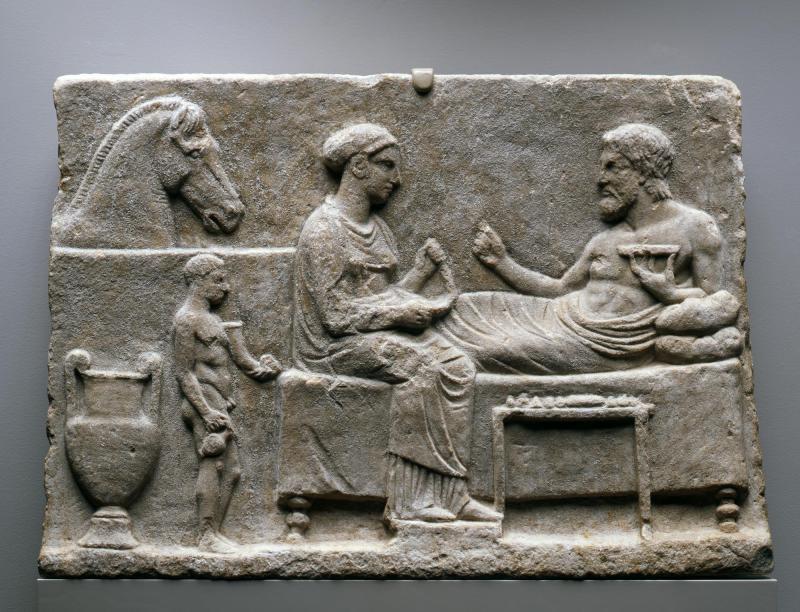
Slavery was widespread across the ancient Mediterranean, and although the form and extent varied from period to period and place to place, the practice remained fundamental to many, if not all, aspects of ancient life. Slavery was especially prominent – though not exclusively so – in Classical Athens (5th-4th centuries BCE) and imperial Rome (from the 1st century BCE). Estimates suggest that in Athens between 450 and 320 BCE, 80 to 100,000 people may have been enslaved, amounting to one in four inhabitants; and that by the late first century BCE in Italy alone, 1 to 1.5 million people were enslaved, representing 15 to 25 percent of the population. Both societies practiced chattel slavery, a form of absolute servitude in which enslaved persons were owned as property and could be subjected to physical violence, sexual exploitation, torture, and death with impunity. Neither Athens nor Rome enslaved people based on ethnicity or skin color but they did discriminate by enslaving non-citizen foreigners, a majority of whom were captured during war or sold by slave-traders. Children born to enslaved parents were also enslaved.
Several objects on display in the Greek and Roman galleries depict enslaved people. Others commemorate the lives of freedmen, and many were likely made by enslaved or formerly enslaved craftsmen. These works demonstrate how deeply embedded slavery was in the Greek and Roman worlds and reveal the vital - though often invisible - contributions made by enslaved people to these ancient societies. Labels exploring these connections were written with Emory students as part of a recent undergraduate course on classical slavery. These can be read by scanning the associated QR codes in the galleries. Printed versions are available at Reception.
This digital exhibition is held in conjunction with Emory's Symposium: In the Wake of Slavery and Dispossession.
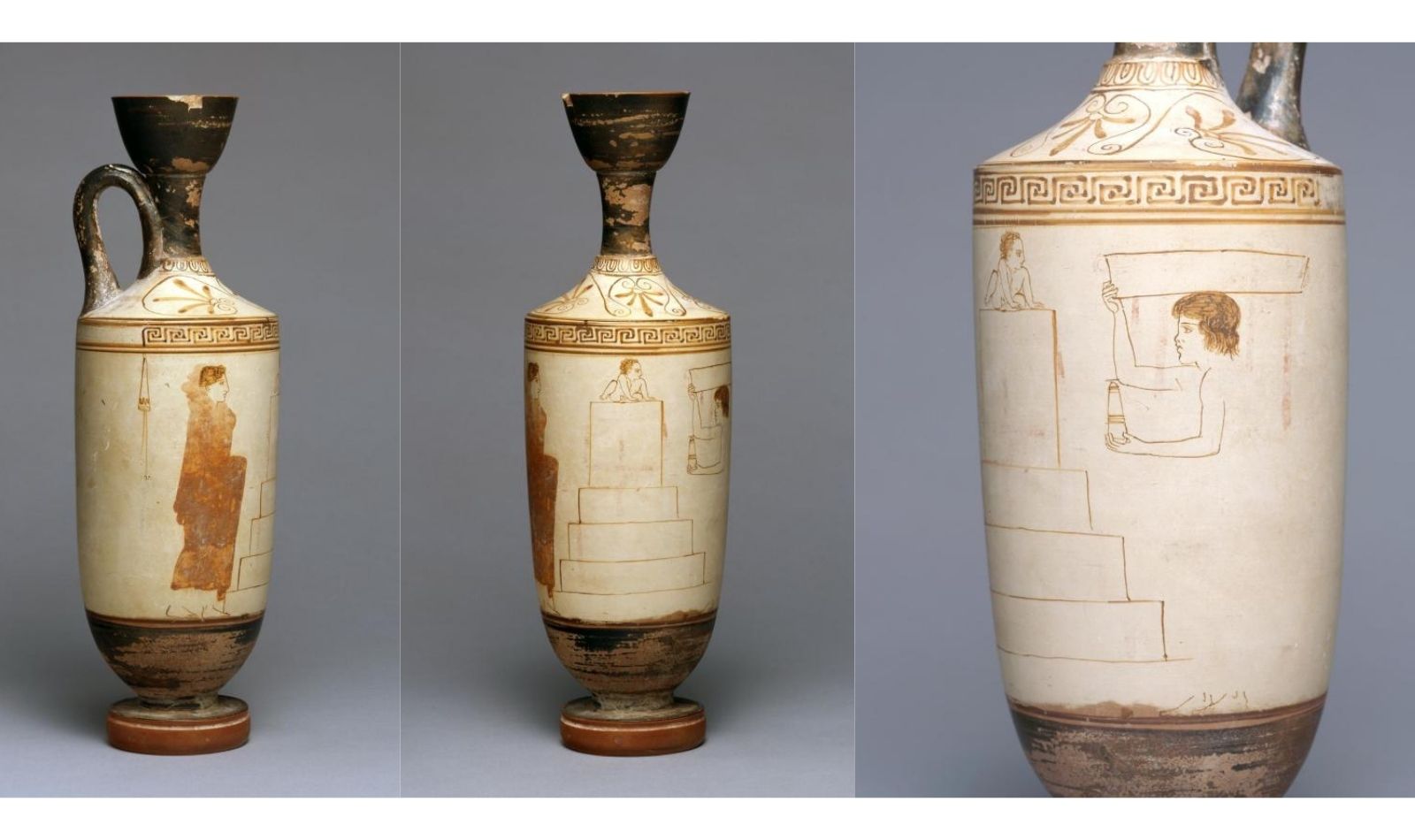
White-Ground Lekythos Depicting a Scene at a Tomb
Greek (Attic), ca. 430 BCE
Ceramic
Carlos Collection of Ancient Art, 1999.011.001
To read more about this object, click HERE.
Athenian artists deployed a series of standardized visual tropes to distinguish enslaved individuals from free citizens. This oil flask (lekythos) would have been used to make liquid offerings at a tomb, and is decorated with an appropriate scene showing an Athenian woman and a female attendant visiting the grave of her son. The Athenian woman is heavily draped and wears her hair in a bun, expressing grief and displaying an idealized female modesty that was expected of elite women. Her profile features are formulaic and accord with Greek standards of female beauty. The enslaved status of the female attendant is indicated by her cropped hairstyle and by her unideal facial features, with snub nose and full lips. Her posture and actions also mark the attendant as ‘un-free’: unlike the Athenian woman, who is unburdened, she carries a heavy basket loaded with ribbons and other offerings for the tomb.
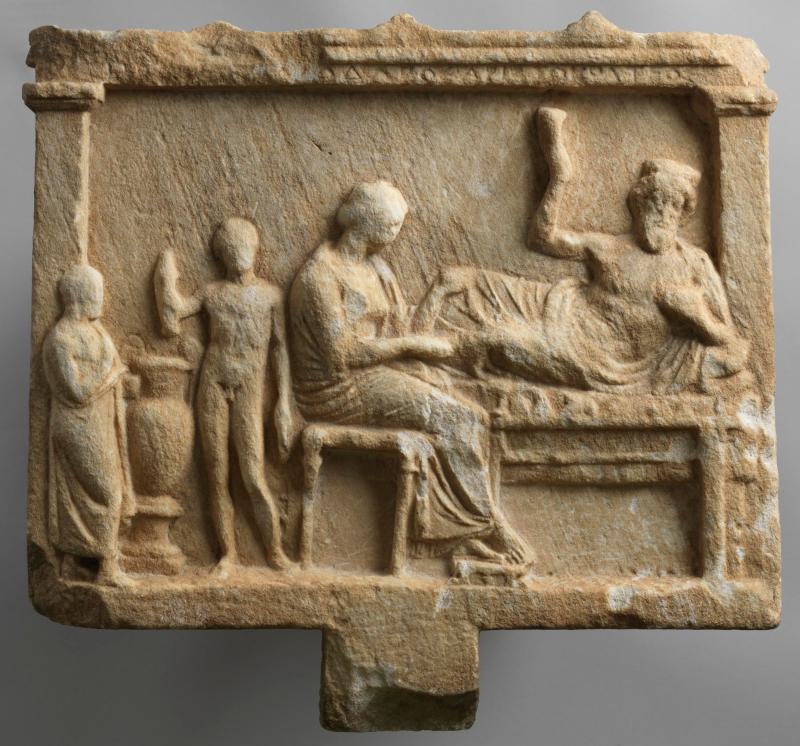
Greek, 400-350 BCE
Marble (Pentelikon)
Carlos Collection of Ancient Art, 1984.16
To read more about this object, click HERE.
This relief depicting a banquet scene was dedicated in a shrine to honor a hero. These were often local men who had achieved fame in their lifetime and received divine status after their death. The iconography of these reliefs is formulaic. Here, the bearded hero reclines on a couch (kline), with food laid out on a table next to him. He is holding a drinking horn (rhyton) and a libation bowl (phiale) and is accompanied by his wife, who wears a heavy garment and carefully styled hair. They are served wine from a large vessel (volute-krater) by a nude male attendant. According to the conventions of Greek art, his small size indicates that he is enslaved. He does, however, have an idealized physique, a desirable characteristic that reflected the wealth and status of his enslaver. To the left is a male worshipper wearing a simple mantle (himation). Like the enslaved attendant, he is also depicted on a small scale to demonstrate his subservience and enhance the status of the hero.
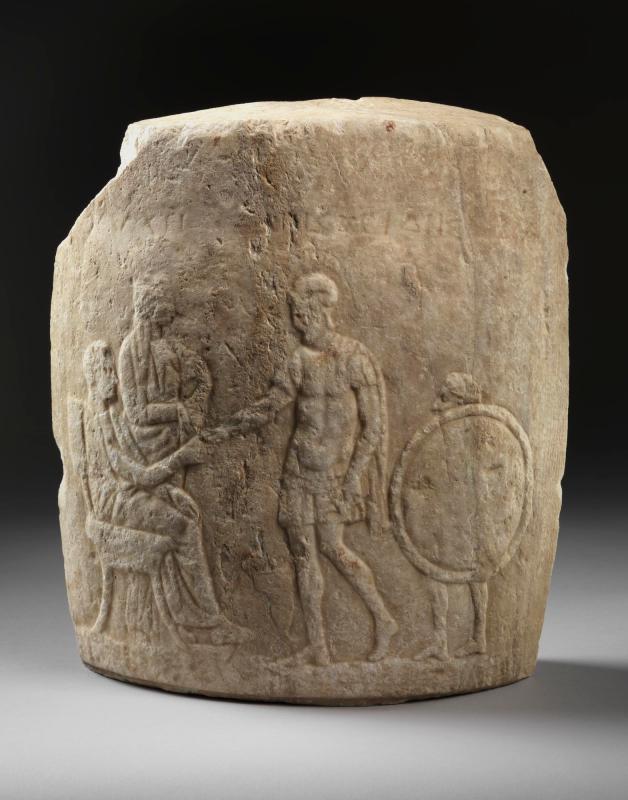
Greek (Attic), 4th Century BCE
Marble (Pentelikon)
Gift of Clara Mont-Claire O’Shea and John S. O’Shea in memory of Patricia O’Shea, 2003.018.001
To read more about this object, click HERE.
Towards the end of the 5th and into the 4th century BCE, the Athenian elite favored stone grave-markers in the shape of vessels known as lekythoi. This relief comes from the upper body of one such marble lekythos and features a departure scene not uncommon on grave-markers of this type. These scenes are often formulaic, and were intended to portray the deceased and their household in a positive light to visitors and passersby. This lekythos depicts a warrior (center) with an idealized male physique wearing traditional hoplite attire: helmet, cuirass, tunic, and cloak (chlamys). He bids farewell to his father, seated, and a woman who is either his mother or wife. To his right, an enslaved servant, shown on a reduced scale to emphasize his low status, carries the warrior’s shield. Hoplites were commonly accompanied by enslaved attendants when they went to war. It is unclear if they participated in battle or only served as noncombatant aides – most ancient sources note them as guides, messengers, and caretakers of warriors’ armor and baggage. The decision to include the enslaved figure in this scene emphasized the status of the warrior, and hence that of the man whose grave the lekythos marked.
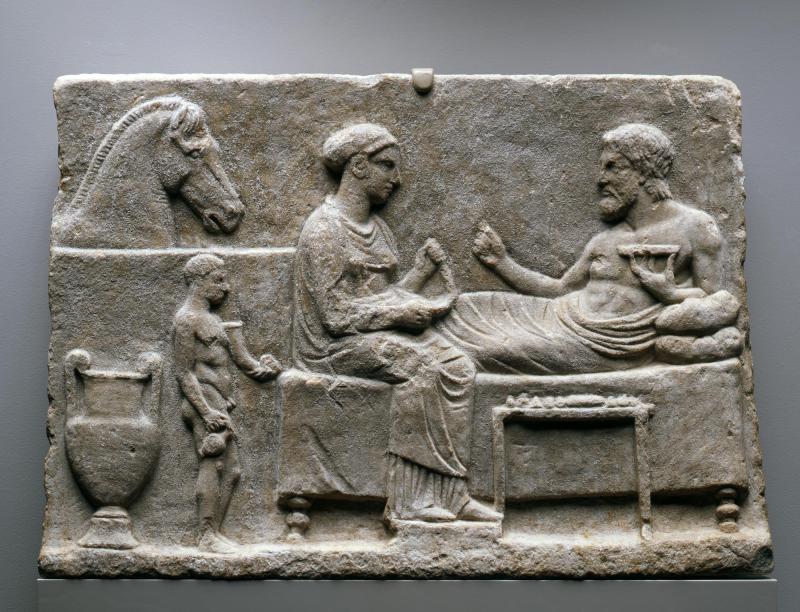
Greek, 4th Century BCE
Marble (Ephesos 2 or Paros 2)
Carlos Collection of Ancient Art, 1999.011.003
To read more about this object, click HERE.
This relief depicting a banquet scene was dedicated in a shrine to honor a hero. These were often local men who had achieved fame in their lifetime and received divine status after their death. Dominating the composition in terms of scale, the bearded hero reclines on a couch (kline), accompanied by his wife. They are attended by a nude male figure, who carries a drinking horn (rhyton) and wine-jug (oinochoe) and is reduced in size to indicate his enslaved status. Behind him is a large volute-krater, a type of vessel used for diluting wine with water according to Greek practice, and a horse’s head shown peering above a ledge. In Classical Greece, enslaved people were often treated as objects or instruments rather than as humans. Here, the enslaved attendant is included alongside the krater and the horse as a prop to signal the wealth, importance, and heroic status of the male banqueter and facilitate his leisurely comfort.
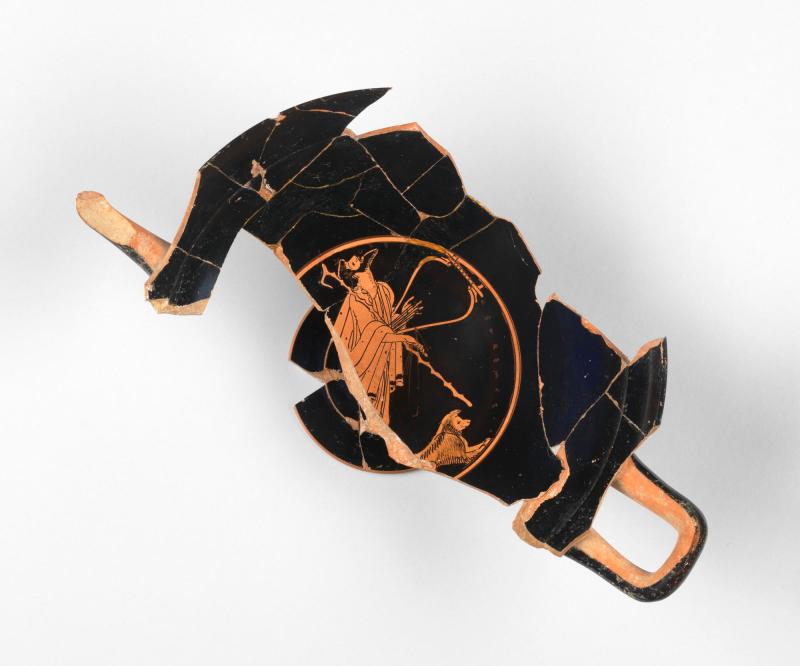
Kylix with a Reveler
Greek (Attic), ca. 480 BCE
Ceramic
Gift of Dr. Dietrich von Bothmer, 2005.058.001
To read more about this object, click HERE.
Many craftsmen working in Classical Athens were either enslaved or had the legal status of metic (resident foreigner, without citizen rights). This fragmented drinking cup (kylix) is attributed to an artist known today as the Brygos Painter. The artist’s real name is unknown, but the painter worked with a potter called Brygos, who ran a successful workshop and sometimes signed his vessels. Some scholars in fact think the painter and the potter are one and the same person. Brygos’ name indicates that he was Brygian, a member of the Bryges tribe who inhabited what is now the Balkans. Athenian enslavers often gave enslaved people names that designated foreign ethnicity, so it is possible that Brygos was enslaved or perhaps had purchased his freedom before establishing his workshop. The names of other artists who signed their vases, such as Lydos (‘the Lydian’) and Amasis (a Hellenized version of the Egyptian name Ahmose) imply similar status.
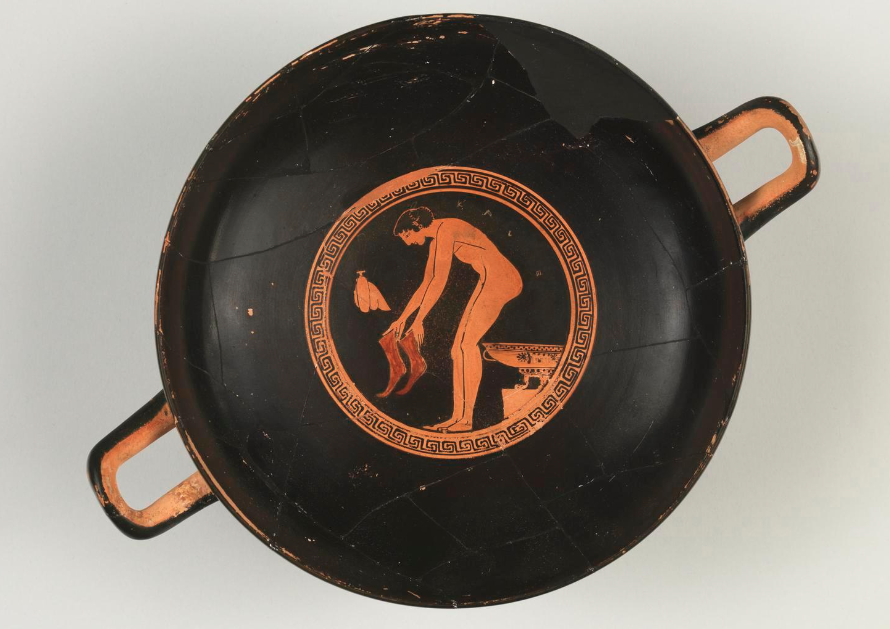
Kylix with a Prostitute Preparing to Bathe
Greek (Attic), ca. 480 BCE
Ceramic
Carlos Collection of Ancient Art, 2003.010.001
To read more about this object, click HERE.
Athenian women were expected to maintain ideals of modesty and chastity, meaning that it was taboo to be seen or depicted naked. It is therefore likely that the woman shown in the tondo of this wine-cup (kylix) is a prostitute. Although prostitution was not condemned in Athens, it was not considered appropriate for citizen women, especially of aristocratic status, and many prostitutes were therefore foreign and often also
enslaved. This cup would have been used at an all-male drinking party (symposion) where the entertainment typically included female musicians, dancers, and prostitutes, who could all be expected to provide sex. Revealed to the user of the cup only once the wine was drunk, this image may have been intended to pique the male viewer’s desire: a Greek inscription behind her back reads ‘KALE’ (‘Beautiful’).
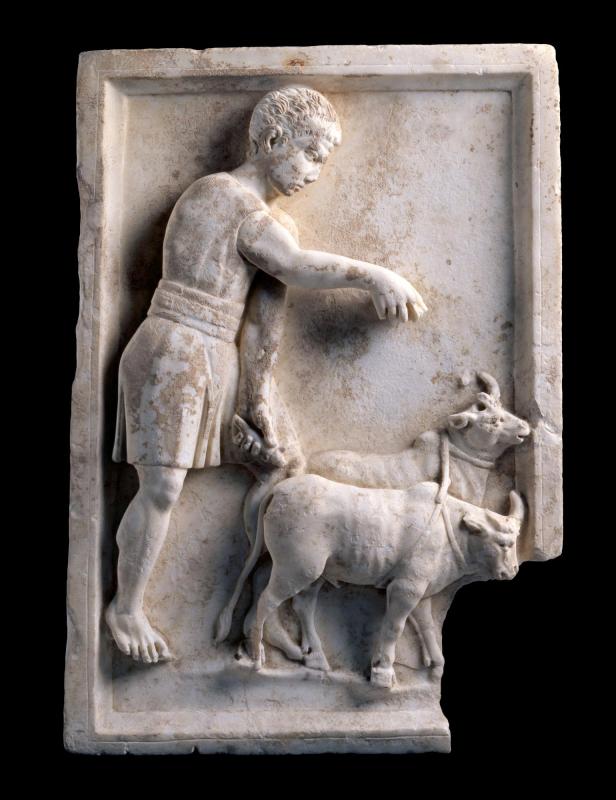
Roman, ca. 200-250 CE
Marble (Göktepe)
Carlos Collection of Ancient Art. Gift of Mrs. Thalia Carlos in honor of President and Mrs. James W. Wagner, 2005.021.001
To read more about this object, click HERE.
Elite Romans idealized rural life. Many owned vast agricultural estates in Italy and across the provinces, which were, for the most part, worked by enslaved laborers as well as freed and freeborn nonelites. These farms were managed by overseers (vilici), who were often freedmen themselves (liberti). It was the responsibilty of the overseer to maintain discipline, to ensure the efficient completion of tasks, and to sufficiently feed and clothe the workforce: enslaved laborers were often considered akin to farm-equipment or livestock, and physical well-being was necessary to guarantee maximum productivity. Laziness, dissent, or revolt would be punished. A treatise on agriculture written by the Roman author Columella advises landowners on how best to manage their enslaved workforce and what characteristics suited a laborer to a specific role. He states that ploughmen should be large and have loud voices to better work the plough and exert authority over the oxen. The exaggerated size of the ploughman on this relief emphasizes these ideals.
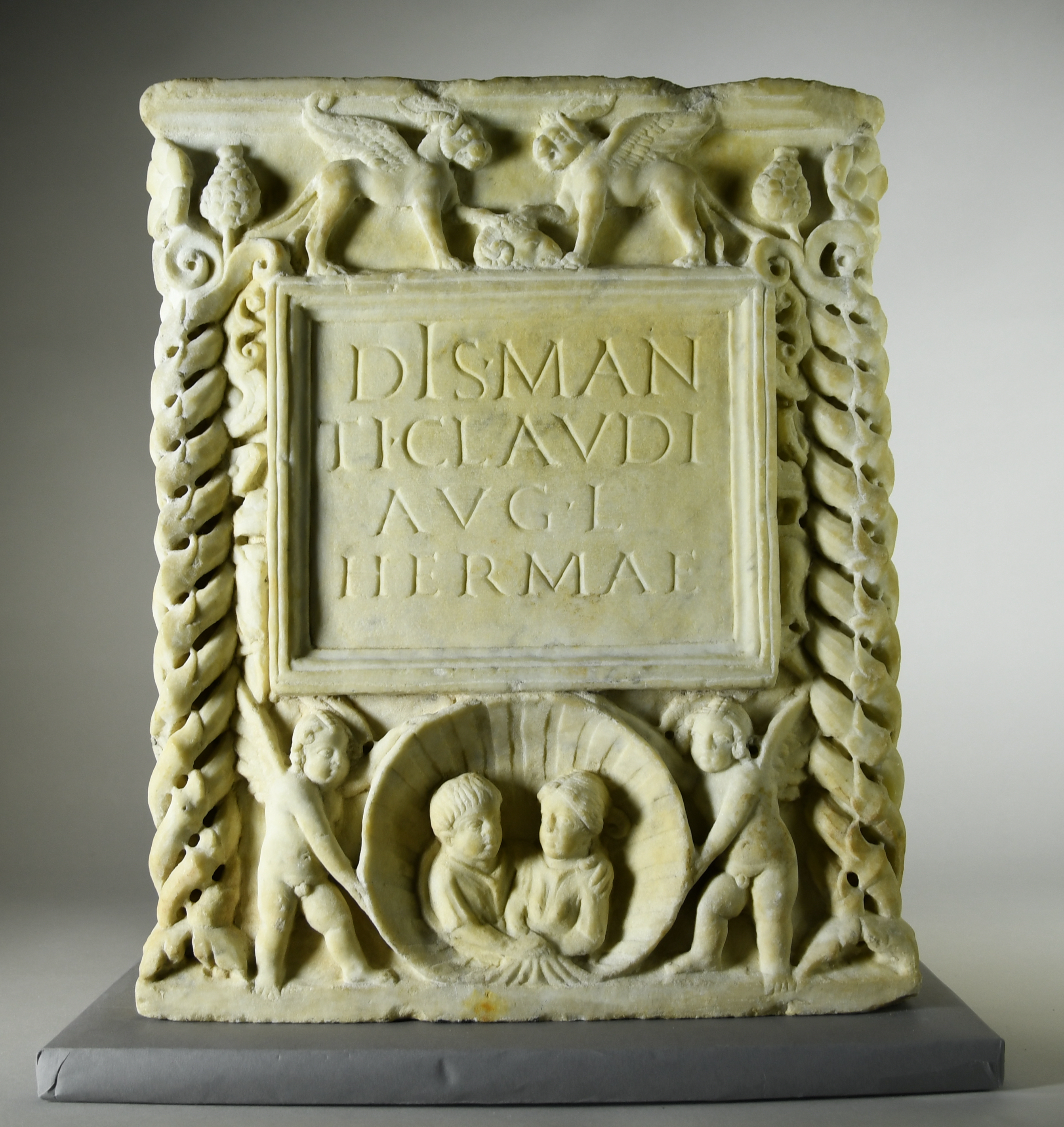
Cinerary Urn for Tiberius Claudius Hermas
Roman, ca. 50-75 CE
Marble
Lent by Lewis M. Dubroff, L1999.031.037
This marble cinerary urn was commissioned to contain the cremated remains of a man called Tiberius Claudius Hermas, who had formerly been enslaved in the household of the Roman emperor Claudius. A Latin inscription on the front of the urn reads: “To the spirits of the departed/for Tiberius Claudius Hermas/ freedman of Augustus”. His name, Hermas (Hermes), is Greek and was common for enslaved men, who were often given Greek names by Roman slave-traders: Hermes was the Greek god of travel, famed for his speed, and the name may have been selected to inspire Hermas to work swiftly. On being manumitted and receiving Roman citizenship, it was convention for freedmen and women (liberti) to then add the names of their former enslavers, in this case Tiberius Claudius (the emperor Tiberius Claudius Caesar Augustus Germanicus - better know simply as Claudius). Hermas, or his family, clearly took some pride in his status as an imperial freedman, choosing to promote this connection to the emperor’s household on his urn. Beneath the inscription are two miniature busts of a man and a woman embracing within a seashell supported by winged cupids. This is likely to be Hermas and his wife. Marriage was a privilege denied to the enslaved, and so this image not only celebrates the couple’s union, enduring into the afterlife, but also Hermas’ freedom and citizen status.
